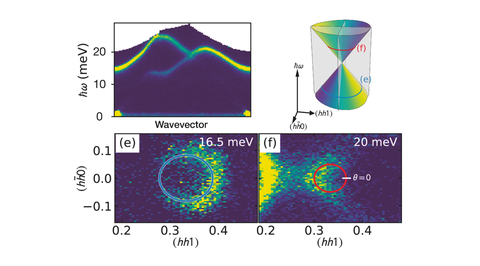Mar 17, 2022
Research: Dirac magnons, nodal lines, and nodal plane in elemental gadolinium
The exploration of band topology in crystalline solids has been at the forefront of condensed matter physics for many years in efforts tying together theoretical physics, materials science and powerful spectroscopic techniques. One relatively new avenue is the exploration of band topology in the spin wave, or magnon, excitations of magnetic materials. Spin wave topology is connected to novel magnetic transport properties, little explored symmetries and surface magnetism and offers a new platform to study interactions. One of the main current directions is to find new materials with topologically interesting band structures and this new study does exactly this by establishing the existence of Dirac nodal lines and a nodal plane in the magnons of elemental gadolinium.
Gadolinium is a hexagonal closed packed magnetic metal in which, at around room temperature, the magnetic moments order into a simple ferromagnetic structure. In this new study, a team of experimentalists at Oakridge National Lab in the US together with theory collaborators explored the magnetic excitations of gadolinium in the ordered phase in unprecedented detail using inelastic neutron scattering. They found that gadolinium hosts Dirac magnons in the form of nodal lines extending along the zone corners. The existence of the nodal lines can be seen to arise from the presence of combined spin rotation and crystalline symmetries providing a first experimental example of the importance of such symmetries for band topology. In the vicinity of the nodal lines, the neutron scattering intensity can be seen to wind around the lines from strong to weak and in antiphase between the two bands (as shown in the figure). This intensity signature is a robust prediction connected to the nontrivial topology of these points. From the existence of the nodal lines one may infer the existence of magnon surface states - a challenging target for future experiments.
Furthermore, the nonsymmorphic crystal symmetries together with spin rotation enforce the presence of a degenerate plane of magnon excitations. Just as the nodal lines exhibit winding of the neutron intensity in their vicinity, the nodal plane is linked to a sharp flip in the intensity on paths crossing through the plane. Both the nodal plane and the intensity jump are clearly observed in the data.
A. Scheie, Pontus Laurell, P. A. McClarty, G. E. Granroth, M. B. Stone, R. Moessner, S. E. Nagler,
Dirac magnons, nodal lines, and nodal plane in elemental gadolinium,
Phys. Rev. Lett. 128, 097201(2022) (arXiv)

